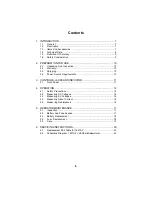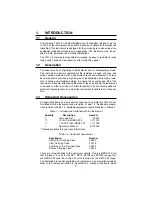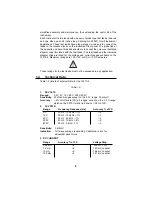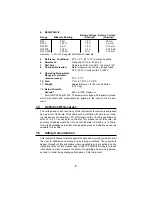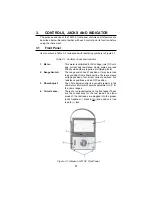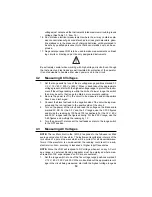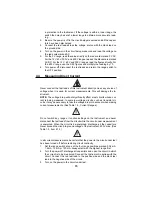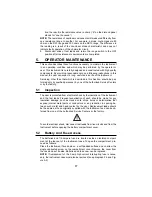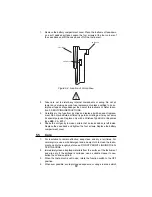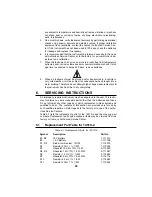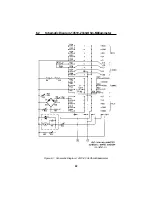
18
5.3
Battery Replacement
Battery replacement is indicated when the pointer cannot be adjusted to zero
on a resistance range.
Remove the battery compartment cover (paragraph 5.3). If zero cannot be
adjusted on the RX1, RX10, RX100 or RX1000 ranges, the 1.5 V battery needs
replacement. Replace with a 1.5 V, NEDA 13F, “D” size cell. If zero cannot be
adjusted on the RX10,000 range, one or both 15 V batteries need replace-
ment. (It is suggested that both batteries be replaced at the same time.) Re-
place with 15 V NEDA 208 battery, Burgess U10, Eveready 411, Ray-O-Vac
208, or equivalent.
Replace the battery compartment cover.
5.4
Fuse Replacement
Fuse replacement is indicated when the Instrument is completely inoperative
in all functions.
The 1/2 A, 250 V fuse is accessible inside the battery compartment. Remove
the battery compartment cover (paragraph 5.3). Carefully pry the fuse from its
clips and replace with an exact replacement. Do not substitute a different type
fuse or rating. It may not serve its purpose and may cause the internal fuse to
blow unnecessarily next time. Replace with a 1/2 A, 250 V Quick Acting
Littlefuse Type 3AG, Catalog No. 312.500, or equivalent.
NOTE: A spare has been provided in the compartment adjacent to the work-
ing fuse as an emergency replacement. If the spare is used, replace it as
soon as possible to assure that it will again be available in an emergency.
If the Instrument now operates (check it in a resistance range by shorting the
test leads together), replace the compartment cover. If the Instrument still does
not operate, the internal fuse may be open. For access to this fuse, the case
back must be removed.
+
+
WARNING
To avoid electrical shock, make certain that test leads are disconnected from any circuits
before removing covers.
NOTE: If instrument fails to operate after replacing fuse (F1) check and replace (F2) inside
case, if required, before returning for repair. See Operator's Manual. No other user serviceable
parts inside. Refer servicing to qualified personnel only.
CARELESSNESS AND MISUSE OF THIS INSTRUMENT CAN BE DANGEROUS
Before connecting this instrument, carefully read the instructions and precautions in the
Operator's Manual. Failure to do so can result in a serious or fatal injury.
SAFETY TIPS
1. Do not attempt any measurements unless trained, qualified and authorized to do so.
2. Do not connect to any circuit where the voltage with respect to ground earth may exceed
1000 volts.
Whenever making measurements with this instrument:
a. Turn off circuit power and discharge any capacitance in the circuit before connectin
or disconnecting test leads or changing switch settings.
b. Double-check for correct swtich settings and test lead connections before applying
power.
c. Do not touch the instrument, test leads or the circuit while power is ON.
d. Do not use any instrument or test leads that are damaged, contaminated, deteriorated,
moist, or which have missing parts.
4. Voltages as low as 30 volts r.m.s. or 42.4 volts peak can render an electric shock.
5. Read the Operator's Manual for additional precautions and instructions.
¯
¯
1.5V
Battery
15V
Battery
Spare Fuse
1/2 A, 250V
Fuse (F1)
15V
Battery
Figure 5-1. Battery and Fuse Compartment
Summary of Contents for 14510-2
Page 1: ...Simpson 14510 2 Volt Ohm Milliammeter OPERATOR S MANUAL...
Page 4: ...4 NOTES...
Page 5: ...5 NOTES...
Page 23: ...23 NOTES...



